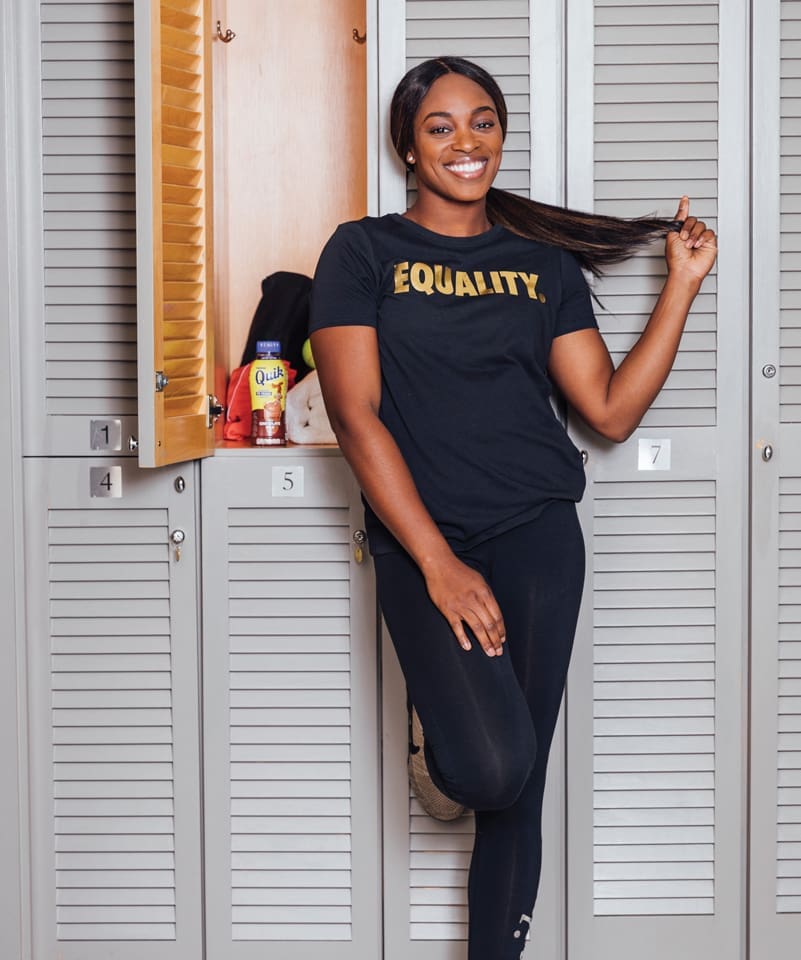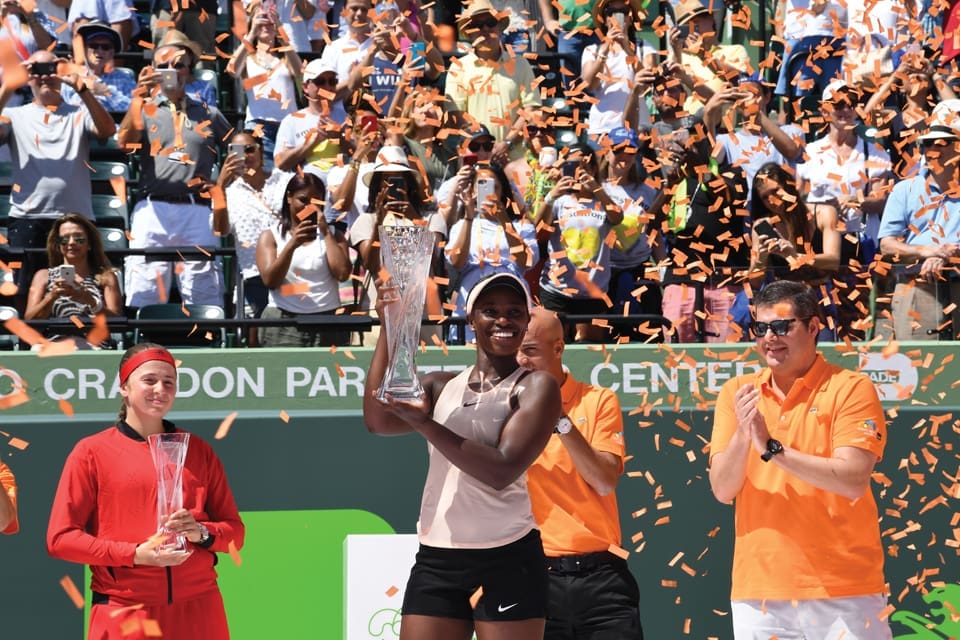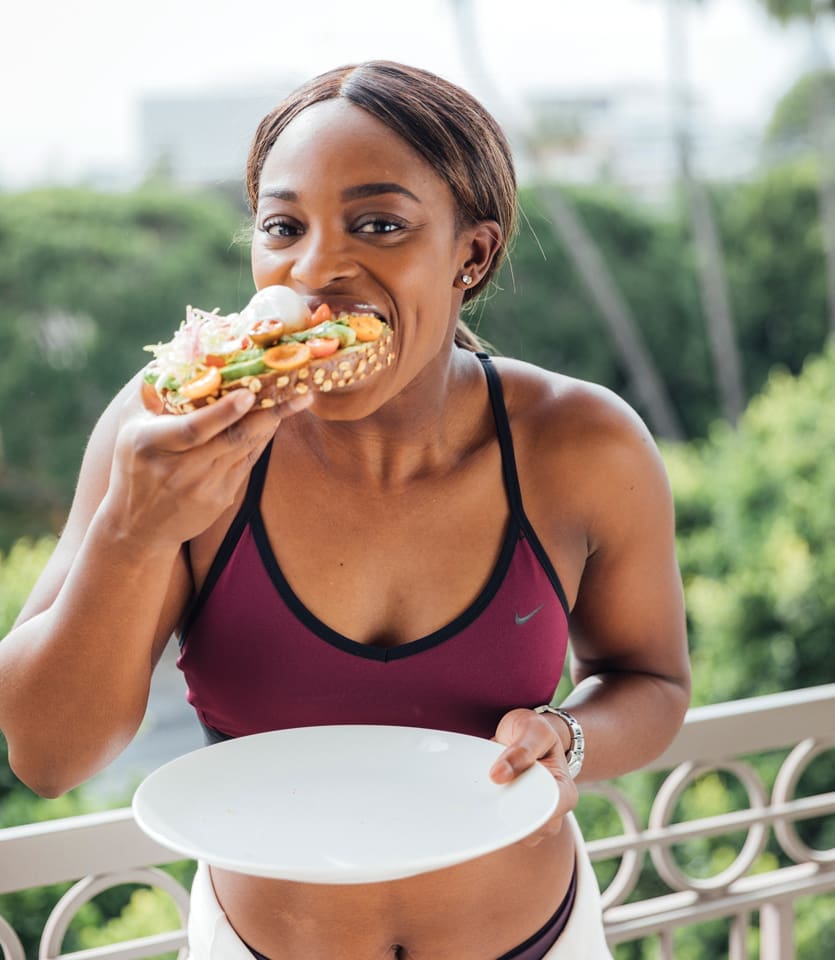Sloane Stephens: Love Game
Tennis champion Sloane Stephens doesn’t let her jam-packed schedule get in the way of her love for South Florida. The 26-year-old U.S. Open Champion sat down with us to talk about her childhood, her love life and what it’s like to beat Venus Williams.

Sloane Stephens went to bed late at her New York City hotel on Sept. 7, 2017, dreaming of becoming a Grand Slam champion. The then 24-year-old tennis star, known for turning defense into offense faster than the ball speeds across the net, had defeated Venus Williams on the sport’s biggest stage earlier that day in a seesaw three-set semifinal match in a clash of generations at the U.S. Open. And if beating Williams, a seven-time Grand Slam winner 13 years Stephens’ senior and one of her childhood idols, at Arthur Ashe Stadium wasn’t impressive enough, Stephens would soon realize another career goal less than 48 hours later: her coronation on the tennis throne as the 2017 U.S. Open champion.
The victory at Flushing Meadows, New York, shocked everyone, Stephens included. Earlier that year, she had undergone foot surgery to relieve a stress fracture and plummeted to a ranking of 957 in the world, only one month before the Grand Slam tournament, where she came in an unseeded player. Looking back, however, it was never a matter of if Stephens would become the next great American player; it was a matter of when.

With a thousand-watt smile and killer court instincts, the No. 4-ranked Stephens is every bit the modern-day champion that American tennis has longed for, a worthy winner to follow the likes of Serena and Venus Williams upon their retirement. In fact, Stephens’ 2017 U.S. Open victory was the first in 19 years by an American who didn’t have the last name Williams.
Like what you read? Click here to subscribe.
Stephens was born in the Fort Lauderdale suburb of Plantation. By all accounts, she hit the genetic jackpot as the daughter of John Stephens, a professional football player who was the second overall running back selected in the 1988 NFL draft, and Sybil Smith, a first team All-American swimmer at Boston University and the first black female swimmer with that designation. With high-level athletes as parents, her destiny seemed to write itself.
“In the fourth grade, I remember people would ask why I had so many muscles,” she says, laughing, in a phone interview from Los Angeles.
Stephens’ mom noticed her natural athleticism even earlier. Stephens began walking at 9 months old, an age when most infants are mastering the art of crawling. “She had a natural balance about her,” Smith remembers. “At 5 years old, in kindergarten, she moved better than the other kids and could run around more fluidly than most. But was she going to be an athlete? Who knew?”
The sports gods, that’s who.
Stephens’ parents divorced, and the mother-daughter pair moved to Smith’s hometown of Fresno when Stephens was 2 years old. Smith eventually remarried, and the family began frequenting the tennis courts, thanks to stepdad Sheldon Farrell’s affinity for the sport. And that’s when Stephens the tennis player was born.
“It was when she was around 9 that I discovered Sloane had great hand-eye coordination,” Smith says.
Stephens’ talent quickly caught the attention of their club’s pros, who began developing her skills. When she was 10, the family returned to South Florida to further Stephens’ tennis development at the renowned academies, including the Evert Tennis Academy in Boca Raton and Saviano High Performance Tennis Academy in Plantation. But if you ask Stephens, much of the decision to move to Florida had nothing to do with tennis.
“It was really for my mom,” Stephens jokes. “She really loved Florida and its simplicity of life. Even though we say that we returned to develop my tennis skills, I know secretly my mom was ready to come back.”
Stephens turned professional in 2009 at the age of 16. Success appeared sporadically. Her first notable win came in the quarterfinals at the 2013 Australian Open, when she beat Serena Williams in three tough sets. From there, her career had as many forward spurts as it did stalls, including an 11-month layoff starting in the summer of 2016 due to her stress fracture.

Today, on a sunny day in late December, Stephens faces a dilemma that doesn’t elude even the most accomplished athlete: finding parking.
She’s driving around her Los Angeles neighborhood, where neighbors are renovating their home. Contractors have been flooding the normally tranquil street, making parking here a premium on most weekdays. “I can’t wait until the construction is complete,” Stephens says.
During the offseason, Stephens splits her time between residences in Los Angeles and Fort Lauderdale, though she calls the latter home, her mom says. She travels to Florida as often as her 11-month-long global tennis season allows, making a point to visit her favorite haunts in the Sunshine State when she’s competing in March’s Miami Open, a tournament she won last year during its final run at Key Biscayne before its relocation to Hard Rock Stadium.
“I grew up playing in Key Biscayne,” she says. “I played there nine years in a row, which was awesome. To be able to win the Miami Open during its last year on Key Biscayne was really special, especially because I was able to have all my family and all my friends in the stands.”
Much has happened to Stephens in the past 18 months. On the positive side, she was declared the WTA Comeback Player of the Year in 2017; won the Miami Open in 2018; reached the finals of the 2018 French Open, coming within a few games of taking the title; and was the runner-up at the 2018 WTA Finals, the season-ending tournament that hosts only the year’s top players.
But defeats persisted. Stephens didn’t win a single match in 2017 after her September U.S. Open victory. She crashed out unceremoniously in the first round of the 2018 Wimbledon Championship and was unable to defend her U.S. Open crown after losing in the quarterfinals the same year. But in speaking about the setbacks, she conveys a sense of calm. Her ability to publicly shrug off a loss is perhaps the biggest weapon she possesses.
“I question whether she has a burning desire to win more Grand Slams or be No. 1,” legend Chris Evert said of Stephens’ perceived laissez-faire attitude in an interview in early 2018. “I don’t see it as much as I do with other players.”
But what some mistake as dispassion, Stephens insists is simply her natural tendency not to dwell on things.

“As you grow and get older, you learn a lot about yourself, you learn about other people, and you learn to manage,” she says. “The more things that happen to you, the more you are able to cope, operate and move past the disappointments.”
Her biggest tip?
“I write notes in my phone. I’ll write about how the last time so-and-so happened I felt like this. That helps me remember my emotions and how I can learn from this circumstance if it were to happen again. For example, the last time we went to Australia, my mom didn’t sleep for two weeks. She was a wreck. So I don’t want her to go to Australia again. The more I write, the bigger my memory bank of these moments becomes.”
For others, including her mom, it took some time to understand that Stephens’ relaxed attitude after a loss doesn’t reflect indifference. While players like Serena Williams are known for passionate temperaments and racket-slamming outbursts, Stephens rarely displays that type of emotion when things don’t go her way.
“When she was 19 or 20, I would tell Sloane, ‘You’ve got to want to win every match,’” Smith says. “But she would say, ‘I’ll get up next time and get that win.’ I learned that’s just her approach after a loss. There’s no doubt she wants to win. She is so gritty and has this fire inside that just comes out. We could be playing tag or playing cards, and she’s just staring you down, ready to pounce.”
And Smith isn’t the only one who understands the pressure Stephens is under. Her international soccer star boyfriend, Jozy Altidore, burst onto the professional sports scene at 16 years old and currently holds the U.S. men’s national team record for the most consecutive appearances with a goal. The two first met at the Boca Prep International School when Stephens was in the fifth grade. The two were friendly, but they lost touch as they grew up and continued their respective athletic careers. Then, as Stephens puts it, “I randomly ran into him in a hallway—I was being really loud while talking to a friend on FaceTime—and I’ve spoken to him every day since. That was three years ago.”
Despite Altidore’s commitments to his club in Toronto and the U.S. men’s national team, and Stephens’ nonstop international career, she says they see each other often.
“People think we barely see each other, but we see each other more than they think,” she says. “If something or someone is important to you, you make time for each other.” Altidore’s support and understanding have provided her with a much-needed rock.

“There are times where I’m crying after a match, and he’s like, ‘It’s fine,’” she says. “He understands what I’m going through. When you’re training, sometimes you don’t want to be bothered, and he understands that. I think another athlete understands that we need our space sometimes. Like, I just ran sprints and my legs don’t work right now, so I just want to relax. Playing at a high level is hard to relate to, and to have that type of understanding is crucial. There have been times when he’ll ice his foot with me, even if he doesn’t need to ice it. It’s nice to have that little support, some love when you need it.”
Although she turns to her guy for “a soft place to land” in those times when she’s feeling vulnerable, Stephens takes a hard line when it comes to issues of equality in professional sports, especially the pay disparity between female and male athletes. She has become an outspoken promoter of women’s tennis, which has evolved from its early days as a sport with delicate ground strokes to a more powerful game with players showcasing a range of shots. In an era where talk about equal prize money for men and women in tennis still exists (a 2018 study stated that the top 100 men in tennis have out-earned women of the same ranking 71 percent of the time), Stephens says the women’s sport has come a long way toward achieving the same vaunted status that the men’s sport has.
“For me, the men’s game is so boring,” she says. “I could never watch a five-set game; it is so boring. I think some of the games I played, excitement-wise, have been pretty fun to watch, even the ones I didn’t win.”
This spring, Floridians will be watching Stephens compete and cheering her on for the win at the Miami Open and beyond. The girl from Plantation is no longer the underdog in any given match. She’s a formidable champion whose dreams apparently do come true.
A FEW OF HER FAVORITE THINGS
South Florida holds a special place in Sloane Stephens’ heart. And so do these Fort Lauderdale eateries.





